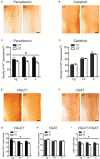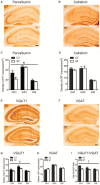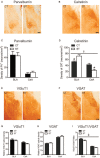Adolescent stress increases depression-like behaviors and alters the excitatory-inhibitory balance in aged mice
- PMID: 31268909
- PMCID: PMC6759106
- DOI: 10.1097/CM9.0000000000000313
Adolescent stress increases depression-like behaviors and alters the excitatory-inhibitory balance in aged mice
Abstract
Background: Depression affects approximately 5% of elderly people and its etiology might be related to chronic stress exposure during neurodevelopmental periods. In this study, we examined the effects of adolescent chronic social stress in aged mice on depressive behaviors and the excitatory-inhibitory (E/I) balance in stress-sensitive regions of the brain.
Methods: Sixty-four adolescent, male C57BL/6 mice were randomly assigned to either the 7-week (from post-natal days 29 to 77) social instability stress (stress group, n = 32) or normal housing conditions (control group, n = 32). At 15 months of age, 16 mice were randomly selected from each group for a series of behavioral tests, including two depression-related tasks (the sucrose preference test and the tail suspension test). Three days following the last behavioral test, eight mice were randomly selected from each group for immunohistochemical analyses to measure the cell density of parvalbumin (PV)- and calretinin (CR)-positive gamma-aminobutyric-acid (GABA)ergic inhibitory inter-neurons, and the expression levels of vesicular transporters of glutamate-1 (VGluT1) and vesicular GABA transporter (VGAT) in three stress-sensitive regions of the brain (the medial pre-frontal cortex [mPFC], hippocampus, and amygdala).
Results: Behaviorally, compared with the control group, adolescent chronic stress increased depression-like behaviors as shown in decreased sucrose preference (54.96 ± 1.97% vs. 43.11 ± 2.85%, t(22) = 3.417, P = 0.003) and reduced latency to immobility in the tail suspension test (92.77 ± 25.08 s vs. 33.14 ± 5.95 s, t(25) = 2.394, P = 0.025), but did not affect anxiety-like behaviors and pre-pulse inhibition. At the neurobiologic level, adolescent stress down-regulated PV, not CR, inter-neuron density in the mPFC (F(1, 39) = 19.30, P < 0.001), and hippocampus (F(1, 42) = 5.823, P = 0.020) and altered the CR, not PV, inter-neuron density in the amygdala (F(1, 28) = 23.16, P < 0.001). The VGluT1/VGAT ratio was decreased in all three regions (all F > 10.09, all P < 0.004), which suggests stress-induced hypoexcitability in these regions.
Conclusions: Chronic stress during adolescence increased depression-like behaviors in aged mice, which may be associated with the E/I imbalance in stress-sensitive brain regions.
Figures





Similar articles
-
Increased vulnerability to depressive-like behavior of mice with decreased expression of VGLUT1.Biol Psychiatry. 2009 Aug 1;66(3):275-82. doi: 10.1016/j.biopsych.2009.02.027. Epub 2009 May 1. Biol Psychiatry. 2009. PMID: 19409534
-
Genetic deletion of monoacylglycerol lipase leads to impaired cannabinoid receptor CB₁R signaling and anxiety-like behavior.J Neurochem. 2015 Nov;135(4):799-813. doi: 10.1111/jnc.13267. Epub 2015 Sep 11. J Neurochem. 2015. PMID: 26223500
-
Early-life stress alters sleep structure and the excitatory-inhibitory balance in the nucleus accumbens in aged mice.Chin Med J (Engl). 2019 Jul 5;132(13):1582-1590. doi: 10.1097/CM9.0000000000000279. Chin Med J (Engl). 2019. PMID: 31045908 Free PMC article.
-
Rodent models of social stress and neuronal plasticity: Relevance to depressive-like disorders.Behav Brain Res. 2019 Sep 2;369:111900. doi: 10.1016/j.bbr.2019.111900. Epub 2019 Apr 22. Behav Brain Res. 2019. PMID: 31022420 Review.
-
Prefrontal excitatory/inhibitory balance in stress and emotional disorders: Evidence for over-inhibition.Neurosci Biobehav Rev. 2019 Oct;105:39-51. doi: 10.1016/j.neubiorev.2019.07.024. Epub 2019 Aug 1. Neurosci Biobehav Rev. 2019. PMID: 31377218 Review.
Cited by
-
Parvalbumin interneuron alterations in stress-related mood disorders: A systematic review.Neurobiol Stress. 2021 Aug 12;15:100380. doi: 10.1016/j.ynstr.2021.100380. eCollection 2021 Nov. Neurobiol Stress. 2021. PMID: 34557569 Free PMC article. Review.
-
The social instability stress paradigm in rat and mouse: A systematic review of protocols, limitations, and recommendations.Neurobiol Stress. 2021 Oct 16;15:100410. doi: 10.1016/j.ynstr.2021.100410. eCollection 2021 Nov. Neurobiol Stress. 2021. PMID: 34926732 Free PMC article. Review.
-
Transcutaneous auricular vagus nerve stimulation ameliorates adolescent depressive- and anxiety-like behaviors via hippocampus glycolysis and inflammation response.CNS Neurosci Ther. 2024 Feb;30(2):e14614. doi: 10.1111/cns.14614. CNS Neurosci Ther. 2024. PMID: 38358062 Free PMC article.
-
γ neuromodulations: unraveling biomarkers for neurological and psychiatric disorders.Mil Med Res. 2025 Jun 27;12(1):32. doi: 10.1186/s40779-025-00619-x. Mil Med Res. 2025. PMID: 40571935 Free PMC article. Review.
-
Itaconate inhibits corticosterone-induced necroptosis and neuroinflammation via up-regulating menin in HT22 cells.J Physiol Biochem. 2024 May;80(2):393-405. doi: 10.1007/s13105-024-01012-3. Epub 2024 Mar 1. J Physiol Biochem. 2024. PMID: 38427168
References
-
- Draper B, Pfaff JJ, Pirkis J, Snowdon J, Lautenschlager NT, Wilson I, et al. Long-term effects of childhood abuse on the quality of life and health of older people: results from the Depression and Early Prevention of Suicide in General Practice Project. J Am Geriatr Soc 2008; 56:262–271. doi: 10.1111/j.1532-5415.2007.01537.x. - PubMed
MeSH terms
Substances
LinkOut - more resources
Full Text Sources
Medical

